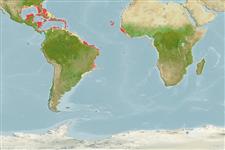Common names from other countries
Teleostei (teleosts) >
Tetraodontiformes (Puffers and filefishes) >
Monacanthidae (Filefishes)
Etymology: Cantherhines: Greek, kanthos = the outer or inner corner of the eye, where the lids meet, 1646 + Greek, rhinos = nose (Ref. 45335).
Environment: milieu / climate zone / depth range / distribution range
Ecology
Marine; reef-associated; depth range 2 - 40 m (Ref. 58047), usually 3 - 20 m (Ref. 40849). Tropical; 33°N - 26°S, 99°W - 14°W
Western Atlantic: Florida, USA and Bermuda to São Paulo, Brazil. Eastern Atlantic: St. Paul's Rocks (Ref. 13121).
Size / Weight / Age
Maturity: Lm ? range ? - ? cm
Max length : 46.0 cm TL male/unsexed; (Ref. 7251)
Dorsal spines (total): 2; Dorsal soft rays (total): 34 - 36; Anal spines: 0; Anal soft rays: 29 - 32. Adults are brown, with or without many prominent white spots on body and head; caudal fin black with obscure curved median white bar and two indistinct white basal spots (Ref. 13442). Males are readily distinguished from females of about same size by the larger spines on caudal peduncle and by orange color of patch of setae anterior to the peduncular spines on males (Ref. 13442).
Inhabits coral reefs or rocky bottoms (Ref. 5217). Found among gorgonians. Occurs in pairs (Ref. 5521). Feeds mainly on sponges, gorgonians, and algae (Ref. 9710) but also eats hydroids and stinging coral (Ref. 13442).
Life cycle and mating behavior
Maturities | Reproduction | Spawnings | Egg(s) | Fecundities | Larvae
Robins, C.R. and G.C. Ray, 1986. A field guide to Atlantic coast fishes of North America. Houghton Mifflin Company, Boston, U.S.A. 354 p. (Ref. 7251)
IUCN Red List Status (Ref. 130435)
CITES (Ref. 128078)
Not Evaluated
Threat to humans
Harmless
Human uses
Fisheries: commercial; aquarium: commercial
Tools
Special reports
Download XML
Internet sources
Estimates based on models
Preferred temperature (Ref.
115969): 24.9 - 28, mean 27.1 (based on 268 cells).
Phylogenetic diversity index (Ref.
82804): PD
50 = 0.5002 [Uniqueness, from 0.5 = low to 2.0 = high].
Bayesian length-weight: a=0.02089 (0.01295 - 0.03371), b=2.94 (2.80 - 3.08), in cm Total Length, based on LWR estimates for this species & (Sub)family-body (Ref.
93245).
Trophic level (Ref.
69278): 3.1 ±0.1 se; based on diet studies.
Resilience (Ref.
120179): Medium, minimum population doubling time 1.4 - 4.4 years (Preliminary K or Fecundity.).
Fishing Vulnerability (Ref.
59153): Moderate vulnerability (36 of 100).
